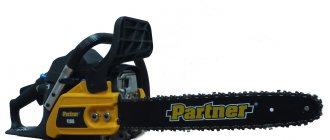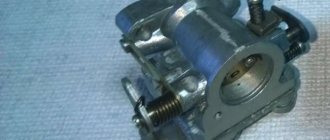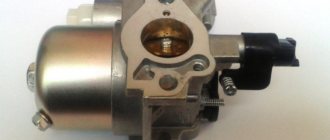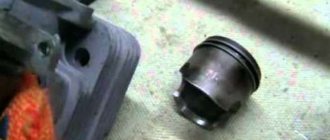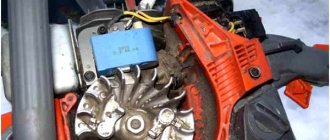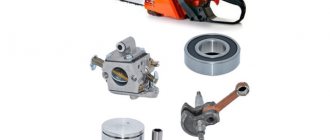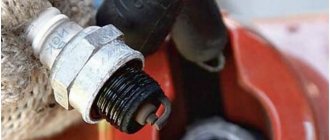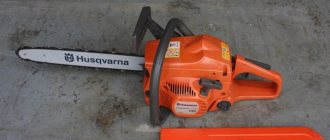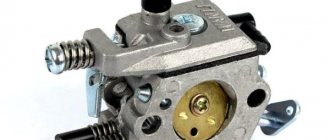Adjusting the chainsaw carburetor
Most chainsaws have three adjustment screws on the carburetor. In order about each:
- T - Idle screw. The idle screw is responsible for the position of the throttle valve when the throttle handle is completely released. If the throttle valve is not open enough, the engine will stall when the handle is released because the throttle valve will cut off the supply of the fuel mixture. If the throttle valve is opened more than it should be, then the chain will rotate, which is strictly prohibited by safety precautions when working with a chainsaw.
- L-Low speed adjustment screw. This screw regulates the amount of fuel in the fuel mixture when the chainsaw is idling. If the amount of fuel is large, the engine will stall under load; if there is not enough fuel, the result will be engine overheating, scuffing, and so on...
- H-High speed adjustment screw. Responsible for the amount of fuel in the mixture when the chainsaw is operating. If this adjustment is set to a larger amount of fuel, then the engine runs “unacceptably” and smokes, and if it is set to a smaller amount, then we get too high speeds and overheating.
Carburetor adjustment step by step
- Check the condition of the air filter. We remove it and either clean it or change it. If the air filter is clogged with dirt and sawdust, the chainsaw will not operate normally.
- We check the condition of the muffler. It must be clean and unclogged. Read more about cleaning the muffler HERE.
- Before you start adjusting the carburetor, you should fill the fuel tank at least halfway.
- If the chainsaw is able to start, then you should let it run for a few minutes to warm up. If the adjustment is carried out “cold”, then the mixture will be over-rich after warming up.
- You need to start adjusting by adjusting the idle speed - screw L. It is highly advisable to have a tachometer, then we focus on 2700 rpm. If not, then we need to find the highest idle speed. In this case, the chain should not rotate!!! If it still spins (the chain, of course, and not the Earth), then we stop it by rotating screw T. The sound of the chainsaw should be like when listening to the file below. https://benzopilatut.ru/wp-content/uploads/2016/01 /chainsaw-idling.wav
- We regulate high revolutions - screw H. If we rotate it clockwise, the revolutions will increase, and if counterclockwise, they will fall. We tighten it until failures appear in the ignition. After that, turn it out about one-fifth of a turn. The sound of a chainsaw when operating at maximum speed should be like this when listening to the file below. https://benzopilatut.ru/wp-content/uploads/2016/01/Chainsaw-maximum-speed.wav
- Let's check how the chainsaw is gaining momentum. She should type them smoothly and quickly. If the speed increases slowly, then turn out screw L slightly.
Remember that the optimal carburetor adjustment is:
- The maximum possible life of a chainsaw
- Optimal fuel consumption
- Good performance
Makita DCS4610 chainsaw device
The design of the Makita DCS4610 branded chainsaw is distinguished by its high density and stability. The internal parts and working mechanisms of the model are placed as close to each other as possible. At the same time, they do not contact each other, which eliminates the risk of friction and overheating of individual elements.
The factory design of the Makita DCS4610 chainsaw is based on a 2-stroke power unit running on a mixture of 92-octane gasoline and synthetic motor oil. The engine consists of an all-metal non-separable crankshaft, a forged piston with one standard and one additional ring, and a chrome-plated factory cylinder with a displacement of 45.1 cm3. The improved layout of the Makita DCS4610 model reduces the specific fuel consumption of the engine - it is 580 g/kW/hour when the internal combustion engine is operating under maximum loads.
The standard design of the Makita DCS4610 chainsaw includes a Zama brand diaphragm carburetor. It is equipped with an enlarged float chamber and a high-performance diffuser that forcibly draws in air to continuously enrich the fuel mixture. The dismountable design of the fuel unit simplifies its washing and self-repair.
The Makita DCS4610 branded chainsaw is equipped with a Phelon ignition system. The assembly includes a durable factory coil equipped with a primary and secondary high-voltage winding, as well as an NGK BPMR 7A spark plug. The combined operation of the ignition system ensures timely ignition of the fuel so that the chainsaw can be started smoothly in any weather. The manufacturer has provided keyless access to the saw's spark plug - this allows the operator to replace it with his own hands.
For the safety of the operator and others during operation of the chainsaw, it is equipped with a mechanical jet brake and a chain catcher. These elements are responsible for the timely stop of the cutting element in the event of its contact with a solid object or breakage.
The internal parts of the Makita DCS4610 chainsaw are housed in a durable plastic case that is highly resistant to heat, vibration and shock. The body is equipped with ergonomic handles covered with high-quality anti-slip material.
Disassembling the carburetor if necessary to check or repair components
To independently adjust the carburetor of a chainsaw, you do not need to be a professional motor technician.
However, you will still have to memorize some aspects of the carburetor’s operation regarding the process of preparing the fuel mixture. Walbro carburetor design: 1 - fuel inlet fitting; 2 - pulse channel of the membrane pump; 3 — inlet valve; 4 — fuel pump membrane; 5 — exhaust valve; 6 — filter mesh; 7 — air damper; 8 — throttle valve; 9 - fuel channel; 10 — idle speed adjustment screw; 11 - needle; 12 — idle jets; 13 - control membrane; 14 - fuel chamber; 15 - main jet; 16 — diffuser; 17 - main adjusting screw
The need for such a device is that the quality of the mixture should be different at idle and under load. At the same time, the channel through which fuel is supplied to the mixer at idle does not close completely when the engine accelerates, and vice versa - the maximum speed channel is slightly undercut at idle.
You can adjust the carburetor of a chainsaw without any disassembly at all; in rare exceptions, you only have to remove the air filter cover. There is a considerable amount of contradiction here: on the one hand, the chainsaw is designed for unhindered access to the adjustment mechanism, on the other hand, it is recommended to access it as little as possible.
True, experienced fellers and sawers always carry a flat-head screwdriver with a long blade and periodically adjust the carburetor. This is explained simply: during the manufacture of a chainsaw, its carburetor undergoes rough adjustments designed for a certain composition of air and fuel. It is clear that the conditions at the work site are different from those on the bench.
When changing the brand of gasoline or, for example, increasing air humidity, an experienced chainsaw user will always adjust the quality of the mixture for greater performance and less wear on the piston part. But this, we repeat, requires considerable experience in working with a specific chainsaw and knowledge of the peculiarities of its behavior. In addition, the adjustment is incredibly fine - the screws are tightened by only 1/10...1/20 of a turn.
Another reason for adjustment is carburetor repair or replacement. In any case, adjustment of the mixture quality should be carried out only if the serviceability of the carburetor is reliably known (no debris, gaskets are not poisoned), the air filter is clean, the spark plug, clutch and ignition system are in perfect order. Otherwise, there is a high probability that the malfunction will be eliminated in a moment and the adjustment will suddenly become incorrect, and the engine will begin to wear out.
The carburetor adjustment diagram and the recommended position of the adjusting screws are indicated in the instructions for each specific tool. When getting acquainted with a new saw, it is recommended to tighten the screws all the way, counting the number of revolutions, so that later you can return the factory settings. The general principles of adjustment are as follows:
- Before making adjustments, the engine must be warmed up at idle speed for 10 minutes.
- By rotating screw L, you need to achieve such a mixture quality that at idle the engine runs evenly at 1500–2000 rpm. In this case, acceleration (acceleration) when pressing the accelerator lever should be fast, but uniform. A dip in the speed increase indicates that the mixture is too lean; the screw must be unscrewed until this phenomenon disappears.
- After adjusting the mixture for low speeds, screw T is tightened until the chain begins to rotate, and then unscrewed 1/2 ... 1/3 turns. Here it is important to monitor the serviceability of the clutch mechanism.
- The H screw is not adjustable in makeshift conditions.
The danger of independently adjusting screw H is that too lean a mixture at high speeds, and especially under load, leads to rapid wear of the piston and failures in the ignition system. You can attempt to adjust high speeds only if three conditions are met:
- The chainsaw obviously does not produce the required power when cutting.
- The person performing the adjustment has general knowledge of carburetor engines.
- A means of measuring engine speed is available.
The latter can be either a tachometer or a multimeter with a built-in oscilloscope. To connect the multimeter, you need to wrap 3-4 turns of thin copper wire around the spark plug wire.
The main task of screw H is to compensate for over- or under-revving due to a change in fuel type, oil concentration or air composition. Also, the “upper” setting can be disrupted by insufficient precision in adjusting the low speed screw. The adjustment scheme is simple - the screw is tightened or unscrewed until the saw engine at maximum gas produces 14.5–15 thousand rpm or the value specified in the operating instructions.
If you use an oscilloscope, its readings (spark discharge frequency) should be in the region of 230–250 Hz. Take into account the accuracy class of the measuring instruments and the fact that under load the speed drops by 10–15%. It is better if the engine runs at low speeds than at high speeds, even if only slightly.
The carburetor serves to mix the flammable mixture with air while maintaining predetermined proportions. If clear doses are not followed, the proper operation of the engine is at risk. When a huge amount of air enters during mixing of the components, but there is not enough fuel, then such a mixture is considered “lean”.
Oversaturation should not be allowed, because with a larger amount of fuel compared to air, malfunctions or engine wear are also likely. Carburetor adjustment is needed not only before initial use, but also when any differences in its operation are detected. Before working with a chainsaw, do not forget to run it in.
Carburetor components
The carburetor design contains a standard set of parts, but may vary little depending on the manufacturer. Components:
- The basis. This is a special tube that is visually similar to an aerodynamic design. Air passes through it. In the transverse direction, a damper is located in the middle of the pipe. Its position can be changed. The more it is extended into the passage, the less air enters the engine.
- Diffuser. This is the constricted part of the tube. With its help, the air supply speed increases precisely in the segment from which the fuel comes out.
- Channels for fuel supply. The fuel mixture is contained in the float chamber, then passes into the nozzle, from which it flows into the atomizer.
- Float chamber. It is a separate structural element, reminiscent of the shape of a tank. Designed to constantly maintain the optimal level of fuel fluid before entering the channel from which air enters.
Don't know which chainsaw to choose? Read our article.
Are you looking for cheaper models, but reliable and time-tested? Pay attention to Russian-made chainsaws.
Or explore foreign chainsaw manufacturers such as Shtil.
Need to do a little research. Acceleration of the device is initiated. It is necessary to evaluate the proper operation of the engine during maximum speed. When the engine is functioning correctly, it means that when you press the accelerator, the speed quickly increases to 15,000 rpm.
If this does not happen or the increase in speed is too slow, you must use the screw marked L. It turns counterclockwise. Moderate movements must be observed, since the turn cannot be more than 1/8 of a full circle.
The design of different carburetor models is almost the same, so when working with them you can use the standard scheme. All elements must be removed carefully and then laid out in the order given below so that you can successfully place the items in place after the completion of the repair work.
Removing the Top Cover
- The top cover is removed. To do this, you need to unscrew the 3 bolts holding it in a circle.
- The foam rubber is also removed, since it is the upper component of the filter that conducts air.
- The fuel hose is removed.
- The drive thrust is output directly to it.
- The cable end is disconnected.
- The gasoline hose can be completely removed if you systematically pull it off the fitting.
To finally prepare the carburetor for major repairs or replacement of the smallest parts, you need to carefully disconnect it from the main system. Sometimes further disassembly is required. You should unscrew the components carefully and put the fasteners in groups, as these small parts are easily lost.
The design of the Makita DCS4610 branded chainsaw is distinguished by its high density and stability. The internal parts and working mechanisms of the model are placed as close to each other as possible. At the same time, they do not contact each other, which eliminates the risk of friction and overheating of individual elements.
Currently reading: Why does the carburetor on a chainsaw overflow?
Technical characteristics of the drive and clutch
Makita DCS4610-36/40, with its own weight of 4.75 kg, differs from similar models in its compact dimensions, which has a positive effect on its functionality and versatility of use.
The tool is equipped with a simple design and durable two-stroke air-cooled carburetor internal combustion engine. Power unit with a displacement of 45.1 cm3 and a power of 2.3 hp. It runs on a fuel mixture made from high-octane gasoline and semi-synthetic motor oil for two-stroke engines.
Fuel enters the Zama carburetor from a 370 ml reservoir located in the body. The engine is equipped with a manual starter with an easy start system, a boost pump, a Phelon electronic ignition system, an effective vibration damper, a joystick control circuit for starting and operating the power unit.
| Model | Makita DCS4610-36/40 |
| Manufacturer | Makita |
| Production (assembly) | Germany |
| Homeland of the brand | Japan |
| Saw class | Household |
| Power, hp (kW) | 2,3 (1,7) |
| Engine volume, cm3 | 45,1 |
| Chain pitch, inches | 3/8 |
| Chain thickness, mm | 1,3 |
| Fuel tank volume, l | 0,37 |
| Oil tank volume, l | 0,25 |
| Tire length, cm (inches) | 35/40 (14/16) |
| Noise level, dB(A) | 101 |
| Warranty, years | 1 |
| Weight, kg | 4,75 |
| Instructions | Download |
Fuel supply system repair
Fuel cannot enter the cylinder for the following reasons:
- Fuel filter is dirty. Remove the fuel hose and check for fuel leaks. If the stream is weak, you may need to clean the filter. It is removed through the filler hole of the fuel tank and cleaned; in case of severe contamination, it is replaced with a new one. As a precaution, it is recommended to replace the fuel filter every three months.
- Clogged breathing tube (holes in the fuel tank cap). Also check by disconnecting the hose to see if the needle is clogged.
- Lack or insufficient amount of fuel. There may be several reasons for the malfunction. The first reason is a clogged air filter. Air stops flowing into the carburetor in the required quantity, and therefore the engine is damaged due to the fuel mixture being too rich. The dirty filter is carefully removed, cleaned and washed with water, then dried and replaced.
Another reason is mismanagement of carbon emissions. Adjustment is carried out with three screws.
Timely replacement of the fuel filter ensures full fuel supply
READ Chainsaw Chain Oil Replacement
The fuel hose and blower drive must be in tight contact with the valve.
The throttle cable should be in place.
You must use instructions when working, otherwise you may only make it worse.
And the last reason is a violation of the integrity of the membrane or clogging of the carburetor channels.
To repair the carburetor yourself, you need to read all its parts
All parts must be clean, dry and undamaged.
How to properly adjust the carburetor with your own hands?
After washing and completely cleaning the carburetor, it is assembled and adjustments begin. First of all, you should understand the purpose of the adjusting screws. The instructions will help with this, but some general points should be considered immediately. The most common designation for screws is:
- H - adjusts the state of the main jet, i.e. adjusts the maximum rotation speed of the motor shaft;
- L — adjusts the idle jets (responsible for the minimum shaft rotation speed);
- T - regulates engine idle speed. It can also be designated by the letters LA or S; on some carburetor models it is completely absent.
Turning screws H and L clockwise leans the fuel-air mixture, and counterclockwise turns it rich (the amount of gasoline increases). When screw T rotates, the shaft rotation speed at idle speed changes - clockwise it increases, and in the opposite direction it decreases.
Before you begin direct action, you should find and carefully study information about the position of the adjusting screws (the magnitude of the rotation angles when adjusting). This information is available in the instructions for the chainsaw. Then you need to prepare the workplace - lay the saw on a flat horizontal plane, pointing the chain in the direction opposite to you. Disconnect all covers, remove foam and air filter. At this point, the preparatory operations are considered completed, and the main part of the work can begin.
Carburetor adjustment procedure:
Smoothly tighten screws H and L clockwise until they stop. Be careful not to break the screws - this will cause complete loss of the carburetor. Unscrew both screws one and a half turns. Run the engine for 10 minutes and warm it up. This is a necessary point, since it will not be possible to adjust the carburetor correctly on a cold engine. By turning screws H and L, alternately adjust the rotation of the shaft at maximum and minimum speed. By adjusting the position of screw T (or it may have a different designation), the idle speed of the chainsaw is adjusted. It is necessary to achieve smooth and stable engine operation
It is important to monitor whether the chain moves at idle or not. If it moves, turn the screw counterclockwise a little more.
https://youtube.com/watch?v=i86KPD7EA_o
You can check the engine's operation visually and by ear. A mixture that is too rich causes thick smoke to come out of the exhaust. When feeding a lean mixture, a whistle is heard while the saw is running. Excessively economical mode is harmful - if screw L is set to “lean” fuel, problems will arise with starting the engine. When setting screw H to a lean mixture, the saw will noticeably lose power. The correct setting can be determined by the following criteria:
- at idle, the engine does not stall, and the chain does not move;
- there is no excessive smoke from the exhaust pipe when the engine is running;
- the engine demonstrates good throttle response (quickly picks up speed when you press the accelerator).
A detailed description of the settings is available in the instructions that come with the tool in the package. It should be carefully studied, since there may be some features or specific requirements established by the manufacturer and relating only to this model of saw. If all requirements are met exactly, the operation of the chainsaw will be restored to its original state.
How to set up a saw made in China?
The design of the carburetor on Chinese chainsaws is no fundamentally different. The order and principle of setting also have no differences and are performed in the same order. The only difficulty that may arise during the work is determining the purpose of the adjusting screws. Typically the T screw is at the top and the H and L screws are located at the bottom of the carburetor body. There may be one more, additional screw.
Figure 3 – Location of adjustment mechanisms
Usually their purpose is determined experimentally, slightly changing the position and monitoring the result. Once the purpose of the elements is clearly defined, further configuration is not difficult and is carried out in the usual manner.
Adjusting the carburetor of a chainsaw is an important and necessary procedure that must be performed periodically to restore the normal operation of the tool. This process does not create any fundamental complexity, but requires the user to be careful, attentive, and follow safety rules. The chainsaw chain is usually not removed, since you will need to observe its position. Therefore, it is important to constantly remember the possibility of its launch and exercise the necessary caution.
READ Chainsaw Makita 4610 Carburetor Adjustment
The adjustment should be made smoothly, with small changes in the position of the screws, so as not to cause too sudden changes in the mode of rotation of the shaft. The result depends on the care and diligence of the user, and a properly configured carburetor will extend the life of the tool.
Chainsaw MAKITA DCS4610. Replacing the carburetor.
Adjusting the Makita chainsaw carburetor
Planned adjustment of the built-in fuel unit of a Makita chainsaw should be carried out on a fully operational power unit. Any violation in its operation may cause incorrect setting of the required engine speed.
Its proprietary operating instructions will tell you how to properly adjust the carburetor of a chainsaw. If the manual is not at hand, then the operator will have to act in the following sequence:
- First, on the saw with the motor turned off and cooled down, you need to turn all 3 adjusting screws clockwise until they stop. Immediately after this, each of them must be turned 1/4 turn in the opposite direction;
- To adjust the low speed, you need to start slowly turning the screw L in different directions until the motor runs as smoothly and stably as possible;
- If, after setting low speeds, the chain on the blade rotates, you will need to find the position of the screw T at which the cutting element will stand still;
- To set high speeds, you need to connect a tachometer to the internal combustion engine cylinder. By turning screw H, you need to find those speeds that will ensure smooth operation of the engine without extraneous sounds.
https://youtube.com/watch?v=i86KPD7EA_o
To check the operation of a Makita chainsaw, you need to turn off and restart its internal combustion engine. If, when the operator smoothly presses the accelerator lever, the engine steadily picks up speed, then the standard carburetor has been adjusted correctly.
Instructions for Chinese
To correctly configure the carburetor of a Chinese chainsaw, you must first remember the factory settings of the device, then turn on the engine. Subsequently, you will have to leave it running for several hours in order to accurately set your own parameters. Sometimes work is carried out only after ten minutes of engine operation, but many Chinese-made models require special handling.
Chinese chainsaw model
Adjustment procedure:
- Activities begin in idle mode. Using the adjusting screws, you need to achieve a systematic increase in engine speed, so you should first let it run at low speeds. A deviation from the norm is the movement of the chain along the bus. In this case, you need to adjust the outer screws to the optimal position so that the chain remains motionless.
- The transition to medium speed speed is carried out. Sometimes the engine starts to smoke. This defect can be eliminated by tightening the screw to supply a leaner fuel mixture.
In this case, the smoke will disappear, but the engine speed will increase. You need to adjust the settings until you reach a level where, when you press the throttle, the engine smoothly picks up speed, and no sudden jerks or interruptions are heard.
The device's engine is being checked. The chainsaw is switched to minimum speed, and then the lever is quickly pressed. When pressed maximally, it is held for 3 seconds. If there are problems with the engine, you need to gradually loosen the screw until the optimal position is reached.
The chainsaw should work for several hours in real conditions. You need to cut wood, and then inspect all the elements involved in this event. If there are deviations, they must be corrected using adjusting devices. When all defects have been eliminated and the optimal settings have been established to supply correctly concentrated fuel, the device setup process can be considered complete.
Makita chainsaws are very reliable tools, but even with them, over time, there is a need for carburetor adjustment and even repair. We will talk about how to do it with your own hands, what you will need and what pitfalls arise in the process in this article.
Chainsaw Makita Dcs 34 Carburetor Adjustment
Do-it-yourself carburetor adjustment on a chainsaw
Adjusting the chainsaw carburetor ensures efficient operation of the tool at full power with economical fuel consumption. The adjustment must be performed with a clean fuel and air filter. For a larger number of carburetors, adjustment is carried out with 3 screws: for maximum and minimum speed and idle speed adjustment.
Screws H and L adjust the ratio of the mixture of gasoline and air, determined by the opening of the carburetor throttle valve. When the screws are unscrewed, the mixture becomes richer, and the speed drops accordingly; when the screws are tightened, the mixture becomes leaner - the speed increases.
The designation H refers to the maximum speed screw that controls the main jet, L. to the minimum speed screw that controls the idle jet. Using screw S, the idle speed is precisely adjusted. Sometimes, to simplify setup, the number of available carburetor adjustment screws is reduced.
Setting up a chainsaw carburetor is divided into two stages - basic (factory settings), carried out with the engine turned off, and final, carried out with the engine running and warm. The exact value of the rotation angles should be taken from the operating instructions for the specific chainsaw. Failure to follow manufacturer's instructions may result in engine damage.
Makita dcs 4610 chainsaw does not start
Makita chainsaw spare parts
Makita dcs 4610 chainsaw repair, repair.
Makita(Dolmar).Interesting case
Chainsaw Makita
/Dolmar does not start. There is compression,
the carburetor
was changed. But an interesting case was discovered.
Basic carburetor adjustment.
The adjusting screws for maximum H and minimum L revolutions are slowly turned clockwise until they stop, and then turned back 2 turns; other settings are also possible
Checking and adjusting idle speed.
We find the highest idle speed, to do this we slowly turn screw L in different directions. After finding the position of the highest engine speed, turn screw L 1/4 turn counterclockwise. If the chain rotates at idle, screw T or (S) should be turned counterclockwise until it stops.
Checking and adjusting the maximum speed.
Changing the maximum number of revolutions is carried out by screw H. When it is screwed in (clockwise rotation), the speed increases, when turned out. are decreasing. Chainsaw engines have the highest rotation speed from 11,500 rpm. up to 15000 rpm. A higher speed is not ensured by the ignition, in addition, it becomes dangerous for the engine. Limit speeds can be determined by interruptions in ignition. If they do, screw H is turned slightly counterclockwise.
If the engine operation is not checked for acceleration and maximum speed, then the adjustment of the chainsaw cannot be considered complete.
When you smoothly press the gas trigger, the engine should confidently and quickly pick up speed from idle to maximum speed (from 2800 rev. to 11500-15000 rev., depending on the unit). If the speed is gained slowly, with a delay, screw L must be slowly turned counterclockwise, but no more than 1/8 of a turn.
After adjusting the acceleration and maximum speed, you should again check the operation of the saw at idle speed. The engine must run steadily and the chain must not move. The chainsaw adjustment must be repeated if this condition is not met, except for the basic adjustment stage.
Source
DIY Makita Chainsaw Repair
DIY chainsaw repair
All malfunctions of chainsaws can be divided into two main groups: engine problems with all its components and systems (ignition, fuel supply system, cylinder-piston group, exhaust system) and malfunctions of other components (chain brake, lubrication system, clutch, tire, etc. .).
Content
Engine malfunctions
- the engine does not start;
- starts but stalls;
- works unstably;
- does not develop power, i.e. It runs fine at idle, but stalls under load.
When repairing a chainsaw with your own hands , you must act by elimination. inspect alternately all the probable causes of a malfunction, starting with those that take the least time to check and eliminate (see here about the structure and operation of a two-stroke engine).
Ignition system
. Almost all types of engine problems listed above can be caused by ignition system failures. Therefore, when they occur, it makes sense to start troubleshooting with a spark plug. This is all the more justified since the state of the latter can provide useful information about the operation of the fuel system. So, if a problem occurs, you need to unscrew the spark plug and inspect it.
The wire is disconnected and the spark plug is unscrewed with a special wrench.
If the spark plug is dry, this means that the problem is most likely not in the ignition system, but in the fuel mixture . Repairing chainsaws with your own hands according to all the rules. You can wrap the spark plug back and get to work on the fuel system. If the spark plug is heavily splashed with fuel mixture, it means there is an excess of it. Everything about repairing a chainsaw with your own hands, adjusting the carburetor on a homelite 4518 saw. This can happen from a carburetor misalignment or a violation of starting rules. The spark plug is wiped and dried, the cylinder is dried by turning off the fuel supply and operating the starter. to ventilate the combustion chamber and remove excess fuel. To repair chainsaws with your own hands, how to repair a chainsaw. Then install the spark plug in place and repeat the start.
The presence of a large amount of black carbon also indicates a malfunction in the fuel system.
The ratio between oil and gasoline in the mixture may be incorrect, the carburetor may not be adjusted, or low-quality oil may be used. The spark plug is washed in gasoline, cleaned of carbon deposits with a needle or awl, the electrodes are cleaned with fine sandpaper and replaced.
In all these cases, it would be a good idea to check the gap between the spark plug electrodes. Depending on its brand, it should be in the range of 0.5-0.65 mm. You also need to check the spark plug seal. If it is worn out or damaged, the tightness of the combustion chamber may not be ensured, which leads to a decrease in compression in the cylinder and problems in engine operation.
Even if, when checking the spark plug, there is good reason to believe that the fault is in the fuel system, you need to check the spark plug for the presence of a spark. At least to be sure that everything is in order. For this:
- put the ignition cable on the spark plug;
- using pliers with insulated handles, apply the thread or nut of the spark plug to the cylinder;
- pull the starter handle and watch. whether there is a spark or not.
READ Homemade For Grinder Do It Yourself
If there is no spark, you just need to replace the spark plug. Do-it-yourself chainsaw repair: lubrication system. As a rule, chainsaws are used in conditions that are far from clean. If the new spark plug does not have a spark, you need to check the condition of the high-voltage wire for a break and contact with the spark plug.
The reason for the lack of a spark may also be a faulty ignition module or a violation of the gap between it and the flywheel magnetic circuit. It should be 0.2 mm. Violation of the gap becomes especially likely if the saw was previously disassembled and the flywheel and ignition module were removed. The gap is set using a 0.2 mm thick gasket placed between the flywheel boss and the ignition module. A faulty ignition module must be replaced.
Having checked the ignition system in this way and not finding a malfunction, you can move on to the fuel mixture supply system.
Fuel supply system
. If by inspection of the spark plug it is determined that fuel is not entering the cylinder, all possible reasons for this need to be considered. Do-it-yourself Makita chainsaw repair. It could be:
- failure of fuel to flow from the tank due to a clogged hole in its lid (breather), while a vacuum is created in the tank, preventing fuel from leaking out;
- contamination of the fuel filter installed in the tank;
- no or insufficient supply of fuel mixture from the carburetor to the cylinder.
To diagnose the first two reasons, it is enough to disconnect the fuel hose from the carburetor and see whether fuel flows out of it or not. If it flows in full stream, the breather and filter do not need to be checked; if it does not flow or flows weakly, we can assume that the cause of the malfunction has been found. The breather is cleaned with a needle. The fuel filter is removed through the filler hole of the empty fuel tank using a wire hook, along with a suction hose, from which the filter is disconnected and cleaned or replaced with a new one. When repairing a chainsaw with your own hands, repairing chainsaws is not complete without cleaning. Chainsaw manufacturers recommend changing the fuel filter every 3 months.
Diagnosis of major breakdowns and repair of Makita chainsaws
Diagnosis of basic chainsaw malfunctions and repair of Makita chainsaws
. And also cleaning the benzop carburetor
Makita dcs 4610 chainsaw does not start
Makita
chainsaws Makita dcs 4610 chainsaw repair
, repair
Insufficient supply of the fuel mixture from the carburetor to the cylinder or a violation of the correct ratio between fuel and air mixed in the carburetor can occur for several reasons: due to a clogged air filter, unadjusted carburetor, clogged channels or filter mesh.
As a rule, repairing chainsaws is not complete without cleaning the air filter, since it gets dirty quite quickly. When this happens, the flow of air into the carburetor is reduced, and the fuel mixture leaving it becomes too rich, which disrupts the normal operation of the engine. You need to carefully remove a dirty filter for cleaning so that dirt does not get into the carburetor. The filter should be cleaned or washed in water with some detergent, dried and installed back.
READ How to Properly Tension a Chain on a Stihl Chainsaw
Carburetor misalignment can be corrected by adjusting it. This is usually done using three screws. maximum and minimum speed and idle speed screw. Adjustment must be carried out in strict accordance with the instructions, failure to comply with which may lead to engine damage. Some saw manufacturers leave only one adjustment screw (idle speed). to prevent unwanted interference by inexperienced users with the operation of the carburetor. For an example of adjusting a chainsaw carburetor, see the article Working with a chainsaw.
If adjusting the carburetor does not help, you need to clean its channels and filter mesh, and at the same time check the integrity of the membrane. Carburetor. one of the most complex devices of a chainsaw, so you need to start disassembling and cleaning it with a full understanding of the responsibility of this operation. It consists of many small parts that have the ability to unnoticeably jump out of their places and get lost irretrievably, so that after disassembling this capricious device, you may not be able to reassemble it.
Below is a diagram of another chainsaw carburetor .
If you do not have experience and self-confidence, it is better to entrust the repair of a chainsaw carburetor to a service center specialist. Sometimes, to properly clean the carburetor, it is necessary to use ultrasonic cleaning.
Muffler
. Often the cause of engine malfunction, especially when the engine runs normally at low speeds and stalls under load, is clogging of the muffler spark arrester with combustion products, which prevents normal exhaust. Repair in this case consists of removing the muffler, disassembling it (if it is dismountable) and wet cleaning it from carbon deposits using detergents. The non-removable muffler is dried with a hairdryer after washing. Remember that carbon deposits contain substances that are carcinogens, and dry cleaning, which could result in their inhalation, is unacceptable. When removing the muffler, plug the engine exhaust hole with a clean rag.
Some of the reasons why the muffler may become clogged. This is the use of a fuel mixture with an excess amount of oil (the amount of oil is more than the manufacturer recommends), and the use of either oil not intended for two-stroke engines or low-quality oil.
Cylinder-piston group
. Do-it-yourself repair of Husqvarna and Shtil chainsaws: video. Malfunctions of the cylinder-piston group are among the most serious. This is wear of the cylinder and piston, scratches and scuffs on their surface, wear or sinking in the grooves of the piston rings, wear of the crankshaft bearings. Most of these malfunctions lead to a drop in cylinder pressure and, as a result, the engine is unable to start, or is unable to produce full power. There are several ways to assess the condition of the cylinder-piston group (CPG).
You can remove the muffler and look through the window that opens, in which part of the side surface of the cylinder is visible. Despite the limitations of the review, it is still possible to obtain a general idea of the state of the CPG in this way.
It is useful to measure the compression in the engine, which is quite informative regarding the condition of the CPG parts. Repairing chainsaws with your own, start repairing chainsaws with your own hands. Everything about repairing a chainsaw with your own hands, the spark plug should be washed into the carburetor. The operation is carried out using a compression gauge installed in the spark plug hole.
READ How to make a stationary saw from a hand-held circular saw
The crankshaft is turned using an electric motor (drill) with a flexible shaft or manually with a starter, while monitoring the pressure using a pressure gauge. The latter for a working chainsaw should be no lower than 8-9 atm (0.8-0.9 MPa). As it decreases, engine power also decreases. At a pressure of 5 atm, the engine may work, but only at idle.
The condition of the CPG can only be accurately assessed by completely disassembling the engine. by disconnecting the crankcase from the cylinder and removing the piston. If the latter has burrs, chips or deep scratches, it needs to be replaced. With regard to the cylinder, if the surface is worn out or damaged, it is possible to bore it to the repair size. Low compression may also be caused by wear or coking of the piston ring. A working ring should be clean of carbon deposits, sit freely in the piston groove and press tightly against the inner surface of the cylinder.
Chain lubrication system
If there is a significant (small is considered normal) oil leakage, you need to check the tightness of connecting the tubes to the pump fittings. They may fall off or crack. Violation of the tightness of the oil line, in addition to drips, can also lead to insufficient lubrication of the chain. The pump begins to suck in air, which affects its performance. Violation of the tightness is eliminated by replacing the tubes or sealing them with sealant.
The most serious failure of the lubrication system is cracks in the oil pump housing. In this case, it will have to be replaced.
Chain brake
Replacement of wear parts
If you do not replace wearing parts in a timely manner, their excessive wear will negatively affect the remaining components of the chainsaw. In particular, if the tire and drive sprocket are not changed in time, increased vibration will negatively affect the crankshaft bearings. The maximum working depth of the sprocket teeth should be 0.5 mm. In practice, sprockets are often operated to a wear depth of 1 mm or more. unaware that this leads to increased load on the crankshaft bearings and accelerated failure. When 3-4 chains wear out, it is necessary to change the tire itself; by this time its wear reaches its maximum values.
The chainsaw bar wears especially hard in the area where cutting is done most frequently, usually. this is the underside of the guide bar. To ensure uniform wear, each time the chain is replaced, the bar must be turned 180° relative to the horizontal axis.
When installing a new chain, a new drive sprocket should be installed. Since under normal load the service life of the drive sprocket is twice as long as the service life of the chain, it is advisable to use one sprocket for alternate operation of two chains. Basic malfunctions of chainsaws and do-it-yourself repairs. Thanks to this, the sprocket and chains wear out almost simultaneously. If a new chain is placed on a worn sprocket, the drive links of the chain will wear out much faster. For cost-effective operation of a chainsaw, always use together: one guide bar, two chain sprockets, four saw chains.
Source
Features of the Chinese chainsaw carburetor
Their design and parameters differ depending on the power and model of chainsaw they are intended for. All of them are almost identical to the original carburetors in design, but not always in quality. Today, all Chinese products cannot be considered 100% rubbish. In turn, according to their quality, they can be divided into three groups:
- Poor quality. Unsuitable alloys are used which oxidize, crumble and break. There is no accuracy of fit, the calibrated holes do not correspond to the required values, which leads to excessive consumption or lack of fuel in the combustion chamber. Critical parts quickly fail. Plastic parts quickly become rough or, conversely, become softened by gasoline and stop working. The axles and wire rods are bent, the threads of the fasteners are torn off. Such products are the cheapest. They are made in semi-handicraft industries using adapted equipment. As a rule, they do not have a name or marking.
- Carburetors are of average quality. These are factory assembled products. They do not skimp on alloys; they have established continuous production with quality control. These are fully functional carburetors that can have a service life even longer than that of the entire chainsaw.
- High quality carburetors. First of all, these are products from global manufacturers whose facilities are located in China. Geographically, they can be considered Chinese, but they are made using the technologies of the company that owns the brand and values its reputation. For example, Japanese Walbro carburetors are produced in China.
In addition, among Chinese manufacturers there are those who rely on high quality. They invest heavily in powerful production facilities, register their own brand and work on its reputation.
Adjusting the Makita chainsaw carburetor
It is necessary to adjust a failed Makita chainsaw carburetor only if the engine is in working order and the air filter is clean. Otherwise, adjusting the unit will not bring the required results.
The algorithm of actions is as follows:
- First you need to start slowly turning the screw L in a clockwise direction until the saw engine reaches maximum speed. Immediately after this, bolt L will need to be turned 1/4 turn in the opposite direction;
- Next, you will need to connect a tachometer to the Makita chainsaw motor. Then you need to start turning bolt H in the direction of the clock. As soon as the readings on the tachometer coincide with the maximum speed indicated in the saw's operating manual, the bolt can be loosened;
- If after these steps the chain on the bar begins to rotate, then you need to alternately turn the T bolt in different directions until the chain stops.
https://youtube.com/watch?v=i86KPD7EA_o
After setting, you need to turn off the saw and start it again. If the adjustment was performed correctly, the tool’s motor will steadily gain speed, and the engine’s fuel consumption will be significantly reduced.
How to clean the carburetor on a chainsaw?
It is necessary to flush or clean the chainsaw carburetor only when it is removed and disassembled. Before cleaning, you need to prepare everything you need in advance: two screwdrivers (plus and minus), open-end wrenches, but preferably a head with attachments, clean rags, a special cleaning agent, a pump and an ultrasonic cleaner (recommended). Before you start cleaning, you need to drain all the gasoline - this is mandatory. After the remaining fuel has been drained and the entire instrument has been prepared, we proceed to cleaning:
- Detach the top cover and remove it.
- Carefully remove the fuel pump diaphragm.
- There are spring clips on the left side of the housing. After they are disconnected, you can see screws under the brackets - these also need to be unscrewed.
- Unscrew the bottom cover.
- By unscrewing the screw, you gain access to the needle valve. It and the spring located under it must be carefully removed, and so as not to dull the needle.
- The air damper is dismantled with a slight longitudinal force, after which the damper axis is removed.
- Lastly, remove the throttle valve, lever and axle.
After the carburetor is disassembled, all parts must be laid out on a flat surface on a clean rag. Carefully inspect each part for blockage or wear. Pay special attention to the jets and inlet fitting. Their clogging is the main reason why gasoline does not flow into the carburetor of the chainsaw.
If any part shows that it is very worn out, it is better to immediately replace it with a new one, so that in the future you do not have to think again about how to repair a chainsaw carburetor. Do-it-yourself cleaning of a chainsaw carburetor is done using a special detergent. You need to rinse each part well, and then dry them with a lint-free cloth, or better yet, with compressed air. All channels are also purged with air.
If you have an ultrasonic cleaner on hand, that's even better. Pour diesel fuel into the bath, carefully place the contaminated parts there for 5-10 minutes and after cleaning, dry them with compressed air.
Assembly is carried out in reverse order. A very important point is the installation of the needle valve - it must rotate freely in the seat. If the petal sticks, lightly press it or push it down so that it sits deeper.
After cleaning, it is strongly recommended to wait 20-24 hours to allow the cleaning agent to completely evaporate. Otherwise, it will mix with the air-fuel mixture and enter the cylinder, leaving carbon deposits on the walls after combustion.
Home page » Adjusting the Makita Chainsaw Carburetor Video
Tools and materials
Diagram of a two-stroke chainsaw motor.
The design of mechanical components of chainsaws is characterized by good reliability and maintainability. Virtually all units and parts have open access. If the necessary equipment is available, they are simply removed for repair or replacement. To disassemble and check the life support systems of a chainsaw motor, you should stock up on the following tools and materials:
- a set of plumbing and assembly tools;
- socket wrench;
- tester;
- pressure gauge for measuring compression;
- probes for measuring gaps;
- needle;
- sandpaper;
- fuel mixture (gasoline oil);
- rags.
Maximum number of revolutions
To limit this indicator, you need to use a screw marked H. To increase the number of revolutions, turn it clockwise, and to reduce them in the opposite direction. The maximum frequency should not exceed 15000 rpm.
If you make this figure larger, the device’s engine will wear out, which will lead to problems in the ignition system. When rotating this screw, you need to take into account the ignition processes of the device. If the slightest malfunctions appear, then the maximum speed value must be reduced.
Read also: Mustard marinade for pork in the oven
Specifications
The saw is characterized by its small size and weight with a fairly powerful engine. This makes its use convenient and reliable in any area where sawing wood is required. The most complete characteristics are given in the table.
Characteristics of the Makita 4610 chainsaw
The engine is two-stroke. It runs on a fuel mixture of gasoline and oil. Has easy starting at positive and negative temperatures. The electronic ignition system contributes to this.
The anti-vibration system together with ergonomic handles make handling the Makita DCS 4610 chainsaw less tiring.
The inertial chain brake installed on the saw operates in manual and automatic modes, which reliably ensures personal safety when handling a running chainsaw.
The chain catcher stops the movement of the chain when it breaks. This prevents damage to the saw and injury to the operator.
Tire and chain. Refers to consumables. When replacing, these parts must be installed in accordance with the instructions for using the Makita DCS 4610 chainsaw
Particular attention is paid to maintaining dimensions
Automatic chain lubrication system. Oil is supplied to the bar only while the saw chain is rotating, which reduces overall oil consumption.
A more detailed review of the Makita 4610 chainsaw is presented in the video
Pros and cons of chainsaws
Like any mechanism, the Makita 4610 chainsaw has certain advantages and disadvantages. The positive aspects include:
- safety at work;
- high engine power;
- economical fuel and oil consumption;
- ease of maintenance;
- light weight;
- possibility of using nozzles.
If you fill in the recommended oil and monitor its level, the oil pump will never fail. And the “plastic gear on the drive” is installed on all brands of saws. So the problem here is definitely not in the pump, and therefore not in the chainsaw. Makita chainsaw carburetor adjustment video review of the makita chainsaw.
Currently reading: Chainsaw carburetor diagram
Operating instructions for Makita DCS4610 chainsaw
The constant assistant and adviser to the newly-minted owner of a chain saw is the operating manual, which covers the following sections in detail:
- Chainsaw design, step-by-step assembly.
- Safety during operation and maintenance.
- Techniques for working with the tool.
- Technical characteristics table.
- Preparing the Makita chainsaw for work.
- Maintenance.
- Trouble table.
- Let us briefly share the information from the sections.
Preparing for work
The tool is put into operation as follows:
- the chainsaw is assembled according to the instructions;
- the headset is attached;
- the chain is tensioned;
- a mixture of fuel and oil is prepared at the rate of 1/50;
- Fuel and oil are poured into the appropriate tanks;
- the Makita chainsaw starts;
- the brake operation is checked, the carburetor is adjusted, the oil supplied to the chain is adjusted, etc.
To prepare a high-quality fuel mixture, take 20 ml. high-quality original Makitovo motor oil for two-stroke engines and 1 l. gasoline with an octane rating of at least 92.
Maintenance
The following simple steps will ensure long-term maintenance of the Makita chain saw in working condition:
- Check the performance of the brake system and headset before use.
- Before starting work, adjust the idle speed, lubricant supply, etc.
- Fill the chainsaw with flammable mixture in a timely manner.
- Monitor the oil level in the tank.
- Clean filters.
- After work, thoroughly clean the tool from dust and other contaminants.
- Sharpen the saw chain in a timely manner.
- Conduct scheduled inspections and repairs in a timely manner.
- Use only original spare parts and consumables.
- Serious repairs should be carried out at service centers.
Malfunctions of the Makita DCS4610 chainsaw
Let's list the main problems of the DCS4610 petrol model:
The engine does not start, stalls:
- no fuel;
- problems with candles;
- wire break;
- carburetor adjustment required;
- the filter is clogged;
- the starter does not work;
- no compression in the cylinder, etc.
A hot engine does not start well:
The carburetor is not adjusted.
The chain does not move:
The chain brake is engaged.
- the air filter is clogged;
- carburetor not adjusted;
- the muffler is clogged;
- The cylinder valve (exhaust) is clogged.
No chain lubrication:
- ran out of oil;
- the furrow is clogged.
We suggest you study the complete operating instructions for the Makita DCS4610 chainsaw.
Carburetor adjustment
In some cases (for example, rough engine operation), carburetor adjustment is necessary. In order to adjust the carburetor you need to:
- Turn the carburetor adjusting screw counterclockwise until it stops.
- Start the engine and let it warm up at high speeds.
- Turn the idle speed screw to stop the chain.
- Turn the screw another half turn counterclockwise.
- Make sure that the engine picks up speed smoothly and also releases it smoothly.
If the carburetor malfunction cannot be resolved, contact your nearest service center.
Makita chainsaw carburetor repair
Symptoms that adjustment is no longer enough and repair of the Makita chainsaw carburetor is necessary:
- arbitrary changes (jump-like) engine power;
- excess fuel consumption;
- increased vibration and popping;
- “sneezing” and unstable engine operation;
And of course, a clear symptom is that the engine does not start or stalls.
To repair the carburetor, you will need to remove it; it is located immediately under the top cover of the chainsaw and the air filter.
Location of the carburetor in a Makita chainsaw.
Basic malfunctions and their elimination
Random changes in power may be caused by damage to the adjustment screws. Eliminated by replacing them.
A popular malfunction that is accompanied by unstable engine operation may be associated with a clogged filter mesh in the carburetor. It can be eliminated by cleaning it.
Damage to the control diaphragm or diaphragm in the fuel pump is also common. The fuel supply needle valve may become clogged, become jammed during a long break in operation, or simply wear out.
Problems can arise as a result of the fuel pump gasket losing its seal. All these carburetor malfunctions can be eliminated by purchasing a repair kit and replacing damaged parts.
Repair it yourself or entrust it to a professional
The question is quite sensitive. You can make a decision to repair a Makita chainsaw carburetor yourself only if you are completely confident in your abilities. Some knowledge of the mechanics and operating principle of the carburetor is required.
The carburetor is a rather complex part of the engine; it has small parts and replacing them requires great care and skill. As for malfunctions, you can fix almost everything yourself, since they boil down to finding the damaged element and replacing it. The parts cannot be repaired; there is no need to edit anything with a hammer.
In general, you need to soberly assess your capabilities; if in doubt, it is better to contact a service center.
Repair kit for carburetor
The repair kit for the Makita chainsaw carburetor includes:
- membranes (control and fuel pump);
- gaskets;
- needle valve (needle, spring, lever).
It is clearly presented in the figure; the parts of the repair kit are indicated by a contour line.
You can purchase a repair kit in a store that sells Makita brand chainsaws, as well as on various online resources. The price fluctuates around 500 rubles.
Appearance and purpose
The Makita chainsaw is distinguished not only by its high quality of technical workmanship, but also by its well-recognized design: the silver steel of the cutting surface goes well with the silver-blue shade of the body and the black color of the handle.
The range of chainsaws includes units of various capacities, which are in demand among both amateurs and professionals. They are used in everyday life, during outdoor activities, and the most powerful models are used in logging.
With their help, the unit can be used as:
- outboard motor;
- winch;
- device for drilling ice or earth;
- wood splitter;
- water pump;
- compressor.
Purpose and use of the Makita dcs34 chainsaw
According to the manufacturer's recommendations, the Makita DCS34 chainsaw should be used to solve simple problems that occur in everyday life. It is ideal for cutting posts when constructing a fence. It can be useful for cutting tree branches or preparing firewood for lighting a bathhouse or lighting a barbecue.
If the Japanese knew where their chainsaw was actually used, they would be shocked. Makita 34 can be found at the sawmill, where it is used by everyone who gets its hands on it. It is interesting that the quality of fuel and lubricants, as well as the proportions of the fuel mixture, in such conditions are not observed or are observed approximately. But Makita, even in such “barbaric” conditions, is able to work for quite a long time.
Also in our country, Makita can be found in small logging plots, where harvesting is not industrial, but private, but the volumes are also large and you have to work a lot with a saw. Of course, with its low-power engine, the Makita DCS34-35 chainsaw cannot cope with felling forest, and no one will even try, but it is convenient to cut off knots, its weight and power allow it.
Since the service life of the Makita DCS 34-35 is not designed for such conditions, after some time it will definitely end up in repair. But this does not stop anyone, because the cost of a household model and a professional one has a significant difference, and if you do your own repairs, it turns out to be more profitable to use a household model.
We invite you to watch a video about the Makita chainsaw, in which the seller talks about the advantages of this DCS 34-35 model.
Structural elements of chainsaws
All chainsaws are similar in structure, regardless of whether they are made in Europe (ECHO, Stihl, Husqvarna) or at home (Cedar, Urals). The main elements are located inside the body - the fuel tank and the engine, and outside - the starter, handle, part of the saw ( tires) with chain. A sharp tug of the cable starts the motor and it is the saw blade.
To begin with, we suggest you familiarize yourself with video clips that show how a chainsaw works and how it works:
From time to time, saws develop malfunctions that require disassembly. What can happen to such a simple mechanism as a chainsaw? At least the following:
- Stops starting;
- It starts but soon stops;
- It ceases to function in context;
- Loses strength;
Most problems are related to engine failures (fuel system, exhaust system, ignition, piston part of the cylinder) or failures of other systems and components (clutch, chain brake, tire, lubrication system). Let's look at the most common faults and how to fix them.
READ Chainsaw Makita Dcs 34 35 Video
The working chainsaw starts with one jerk and does not cut

